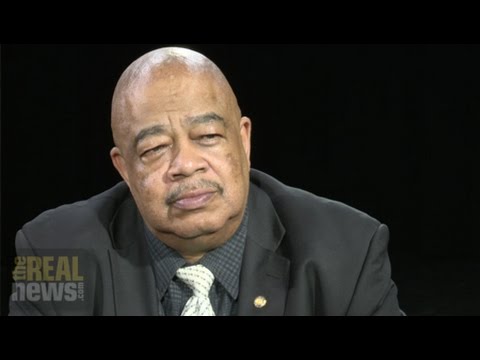
Investigative Journalist Stephen Janis interviews Sgt. Louis Hopson, whose decades long battle fighting discrimination inside the Baltimore Police Department came at a high personal cost
Photography: Cameron Granadino
Studio: David Hebden, Adam Coley
Story Transcript
STEPHEN JANIS, TRNN PRODUCER: Hello, my name is Stephen Janis. I’m reporting for The Real News Network in Baltimore. Racism and the criminal justice system. It’s a topic that has been front and center across the country since the shooting of unarmed African-American teenager Michael Brown, and the death of Staten Island resident Eric Garner at the hands of police, particularly when a report from the U.S. Department of Justice revealed that the Ferguson Police Department was systematically targeting African-Americans with moving violations and court fees to generate revenue for the city. The report raised questions not just about the fairness of the criminal justice system there, but the purpose it served altogether. But even with heightened attention to the topic, few expected the commissioner of one of the largest police departments in the country to weigh in with any candor. But that’s exactly what Baltimore Police Commissioner Anthony Batts did last month during a hearing of the President’s, Barack Obama’s task force on 21st-century policing, when he said Baltimore had a 1950s-style racial problem. And even more specifically last week, when he said that racism was one of the root causes of crime and violence in the community. Joining us to discuss these provocative remarks is a police officer who is no stranger to the topic, Sgt. Louis Hopson is a thirty-year veteran of the Baltimore City Police Department. He was also a lead plaintiff in a landmark federal discrimination suit against the department which resulted in a $5 million settlement and promise of reform. In the lawsuit, Hopson and fourteen other officers alleged the department was systematically discriminating against black officers through the use of a systematically prejudiced internal disciplinary system. Hopson has also been at the forefront of this discussion about race and police for years. Sgt. Hopson, thank you for joining us. SGT. LOUIS HOPSON, BALTIMORE CITY POLICE DEPARTMENT: Thank you, Mr. Janis. JANIS: Well first of all, just what are your … why don’t you talk about the commissioner’s comments? What’s your take on it? HOPSON: I think the commissioner’s comments were very timely. I think that there has to be a conversation, especially about race and race in the criminal justice system. I think especially nowadays it’s important to note that this commissioner, like all commissioners, got a wake-up call. You know, got a true understanding of what racism really is and how it affects society in general. JANIS: The report from the Justice Department said the Ferguson Police Department was basically targeting African-Americans. How does that compare to Baltimore in some of the things that, police strategy we had in the past, in terms of zero tolerance? HOPSON: I think it’s … you know, if you look at what happened in Ferguson, it’s really just another Baltimore City. It’s a major city in the United States of America. It’s basically a small town. We have the same problems that Ferguson have, and it’s kind of sickening. I’ve read the report, and I, I thought they were talking about Baltimore, they could just change the name to Baltimore. For years we’ve had those type of reports here. JANIS: Well, and that raises a good question. If, indeed, we knew that Baltimore was similar to Ferguson in the way its policing was constituted, why wasn’t anything done about it? HOPSON: I think it’s a multitude of reasons. One, I guess we had a black mayor, and people felt that because we had a black mayor that we didn’t really have to do anything about it, that it wasn’t an issue. I think at the … I think at the root cause of all this, it’s simple. It’s that it’s money. I think it’s racism, I think that we’ve never dealt with racism in policing. And there are unions involved, there are police organizations involved, and there’s many factors that go into, while we haven’t dealth with it here. JANIS: Let’s talk about money. I mean, what role does money play in policing in Baltimore City, and how important is it to this idea that policing, or the criminal justice system, is racist? HOPSON: Well, the whole system is set up on the making of money. From the juvenile justice center to the adult center, everybody makes money off the African-American citizens. They make money in various ways. They make money in bail, bail money. They charge you extravagant bail amounts. They make money in the court fines, they make money in the quota system, which they get money from the federal government. They make money in requesting grants so we can supposedly fight this war on crime, which is a war on poor people, and a war on people of color. So everybody got their hands in the pot, and taking it out and getting money. JANIS: One of the things your lawsuit alleged was that police officers were being disciplined–African-American officers were actually being disciplined unfairly. Tell me how that worked, and how the police department was able to create two tiers of justice internally. HOPSON: Well it’s very, very simple. You know, I started realizing it was when … there’s an old adage, you know, about crooked cops. You know, I always contend that there’s no such thing as a crooked cop. Only either you’re a crook or you’re a cop, it’s just that simple. What I tend to find out is when African-American officers tend to see corruption, they would file a complaint. That complaint would somehow be put on the shelf, and then they would finally … a complaint would also be lodged against you within about thirty or forty days. At that time, you would then be brought up on charges and terminated, or stifle your complaint. These complaints came from all-white units, and it kept the police department exactly where they wanted to be. JANIS: Would you be willing to talk a little about what happened to you when you were promoted to sergeant, some of the things that happened to you when you were transferred, and you’ve talked about them in your lawsuit? HOPSON: Absolutely. I was an up-and-coming young man in the police department, I went up the ladder very, very very quickly. I was the first African-American to work operation in what is called the Southern District unit. I was the first black to work narcotics in that unit. And I worked on a lot of your major cases. But I always tend to find that I was always kind of pushed when I got close to who was the real culprit in a lot of the monies that was coming into Baltimore city, insofar as major drug dealers. I would always find myself being shifted to another set of cases. So it didn’t surprise me when I end up getting promoted. One of the, I figured if you get promoted, you could make some changes within the agency. So I, you know, after working on all your plainclothes units and working all your specialized units, I took the test and I did rather well. Once I got promoted, I went to a place called the Northeast District, and it was nicknamed the country club. I didn’t know what that meant until I got there. The very first day I got there, that was myself and another African-American sergeant. Unbeknownst to me, the District was predominantly all white, especially supervisors, and I got an awakening, so as they say. This is the Department’s way of handling discrimination, was to take two mature, experienced officers and put them in a district like this. It really didn’t work. So I was kind of set-upon when I got there. They did such things as move my desk. They put dog mess, wrapped in an African-American newspaper, put it on my desk. My wife, who’s not African-American, they took pictures of my wife and wrote the words “n-lover” underneath of it. My children were biracial, they would draw zebra stripes and post them on the bulletin board. They’d done a host of things until I got to the point where enough was enough, you know. And you don’t, the problem I’d find with African-American officers is, they tend to suffer in silence a lot, and that was one of the things that I had kind of done until I got tired of it, so I filed a complaint. Once I filed a complaint with the Internal Investigation division, I was told that the Department didn’t recognize discrimination in the agency. And by the time I got back to the District, everybody knew what the complaint was, and it really sort of ramped up the treatment that I received. So they took officers from my squad, and there was a whole host of things that they had done to try to undermine my authority, and also they tried to bring charges on me for anything that they could find. JANIS: You said they went through your garbage, and kind of tried to threaten your personal life, to a certain extent. HOPSON: Well, that was just a little later. They took garbage and stuff like that, put it on my desk, destroyed my computer. They did a lot of things at the District. Once I had had enough and I filed a complaint, I realized it was useless so I went to the chief patrol, to the Commissioner. They kind of shrugged it off and, and didn’t do anything about it, so I kept up with it. And I continued to file complaints, and the more complaints I filed, it seemed like, the more they were trying to come after me. Until they got to a point–one day I was in the District, and one of our officers had called and advised me that they had an African-American youth that was in the hospital. So my inquiry–it had happened in my sector, so when I went to investigate it, I found out the young black man was a Morgan State student and he had been beaten into submission, to where he could just barely breathe, and he was in the hospital. I found out they [inaud.] and beat him unconscious. So I filed a complaint on that, because I felt it’d been unnecessary for, you know, only thing the kid did was he was in the telephone booth and he was making a phone call. So once I filed my complaint and I stood by that, then I got into, I had to make some changes here. JANIS: Well, in other words, you—so you pretty much put yourself in the middle of that debate over at City Hall. You became sort of a, to a certain extent a political figure in that debate, and you sort of paid a heavy price for it. The department basically ran you out for a little bit, right? HOPSON: Well, if you consider being terminated three times, and a host of a thousand and one charges, yes. Yes, I did become involved in the political debate. I also had rallied enough African-American officers who had been in similar type of situations. I was then charged by the Vanguard Justice Society, which is the black police officers’ organization here, to conduct an investigation. So I had to pick some of the officers, and I started looking at things such as hiring, termination, promotions, and it’s a double tier of justice that we see there, this double standard. Once I started looking at it many of the myths that we had, African-American officers weren’t smart enough to be promoted, you know, I was able to quickly see right through that and establish evidence of the contrary. We had, at the time, I think eight to nine percent of African-Americans who were police officers, and according to the Department, that’s because they counted the maintenance man, the trash man, and everybody else that, you know, of color. We were really about six percent. I ended up dragging the Commissioner, because they kept denying that these things that were happening, so I’d bring him down to Annapolis, and over to City Hall at different hearings. And I would prove the case over and over again. Each time I proved the case, took him down to City Hall, I had a report made. One report was made by Martin O’Malley, the legislative investigative committee chairperson. I had a report which was authored by the CRC, the Community Relations Commission, by Alvin Gillard. And I was ordered by the mayor, Kurt Schmoke, at that time. There were numerous other reports that were generated, including the Department had to generate reports. All these reports centered on discrimination in the Baltimore City Police Department, and I’ve long been a proponent, or person that said, if you would treat your own this way, if you treat African-American officers this bad and this horrible, imagine how you would treat the average African-American citizen out here. And true to form, once we started looking at the effect, the cause and effect, and how it affects the citizens, and quite naturally it was a certain amount of brutality that went against the citizens. A certain amount of disrespect that was generated to the African-American citizens. JANIS: Eventually though you had to file a lawsuit. Why did you make that decision to actually go to court? HOPSON: After every attempt to try to get the department to change their ways. They’re stubborn. Just like any police department in the United States. It’s a denial that these things are happening. I imagine if you were to speak to anybody in the Ferguson Police Department, they would say you’re crazy. We don’t do that. It wasn’t till the DoJ report came out when they showed you statistical information and facts, they showed you witness information, that they had to admit that yes, we had somewhat discriminating, racist behavior. Even to this day, they still won’t admit it. And in their news conferences, you see that. It goes to show, just like in the Baltimore City Police Department, they never admitted they had a problem, and to this day they still don’t admit they had a problem. It took Commissioner Batts to say that we had a problem. JANIS: Well now, you know, Baltimore City, Ferguson, you’re making comparisons. The discussion has started, but where do we go? Where are we, now, in policing in Baltimore and in general? HOPSON: Actually, a lot of people believe that we’re in a very dark place. I tend to not believe that. I tend to believe that we’re in a very good place. You know, just like in Selma, Alabama. Just like in the civil rights movements. We were in a dark place there, too. However, people came together. And this, to me this is just a, a changing of the guard. It’s another step forward, it is a social issue that has to be addressed. You know, I always said that you can’t, you can only put your foot on people’s neck so long till either two things are going to happen. One is he’s going to succumb and let you kill him, or he’s going to get up and knock that foot off. I think what you’re seeing now is that society’s getting up as a whole and knocking that foot off. Policing has to change. JANIS: Sgt. Louis Hopson, thank you for joining us. My name is Stephen Janis, reporting for The Real News Network, from Baltimore.
End
DISCLAIMER: Please note that transcripts for The Real News Network are typed from a recording of the program. TRNN cannot guarantee their complete accuracy.



